In Laos, we are familiar with one variety of Alpinia, called Galanga, kha in Lao, which is a major ingredient in the local cuisine. Alpinia purpurata is one of the strongest markers of the tropical landscape, with its strange and beautiful inflorescences.
Native to Indonesia and the Pacific, it has an ancient place in the classification of the Zingiberaceae family. Dedicated to Prosper Alpini, an Italian botanist of the Renaissance, this genus includes about twenty Asian and Oceanian species which develop, from a rhizome often rich in odorous resins, a stem with the appearance of a strong reed furnished with simple sheathing leaves; those of Alpinia purpurata measure from 30 to 70 cm in length with a very pronounced central vein. At the end of the stem appears a large, erect spike, sometimes hanging, composed of bright red or pink bracts, in the hollow of which are born very small, extremely discreet white flowers. The fruits are 3-celled capsules containing spherical black seeds.
The vernacular names of Alpinia purpurata, the purple alpinia, recall the colour of its inflorescence: kha dèng in Lao, “red galanga” or Red Ginger in English; the Creole of the West Indies will speak of lavande, because the erect spikes of the Alpinia resemble, in a much smaller way, those of the Mediterranean plant.
In the Pacific, the Alpinia is used to make necklaces and crowns, while in Laos it decorates gardens with its abundant foliage and rich colours. In addition, its sumptuous bracts are increasingly used to give florists’ bouquets an appreciable volume. You know of course that the reproduction of this beautiful plant is easy by taking the shoots from the faded inflorescences which are then put back into the ground.
However, the Lao flora is rich in other Alpinia, and we would like to mention another one: Alpinia bracteata, which is known here as kha khom, “bitter galanga” and which is a famous medicinal plant. Its bracts, although less voluminous than those of purpurata, are nonetheless very beautiful with more visible white flowers with an orange heart. But it is obviously its rhizome that is sometimes used as a condiment and, above all, gives decoctions that strengthen young mothers and cure stomach aches and flatulence.
Nor should we forget the magical powers of the Zingiberaceae, most of which are used to combat evil spirits; thus, among the Akha, a whip made of Alpinia leaves is used to strike the possessed person.
Nous connaissons bien au Laos une variété d’Alpinia, le Galanga, kha en lao, qui est un ingrédient majeur de la cuisine locale. Alpinia purpurata, quant à lui, par la beauté de ses étranges inflorescences, est l’un des marqueurs les plus forts du paysage tropical.
Originaire d’Indonésie et du pacifique il occupe une place ancienne dans la classification de la famille des Zingiberaceae. Dédié à Prosper Alpini, un botaniste italien de la Renaissance, ce genre comprend une vingtaine d’espèces asiatiques et océaniennes qui développe, à partir d’un rhizome souvent riche en résines odorantes, une tige ayant l’aspect d’un fort roseau garni de feuilles engainantes simples; celles d’Alpinia purpurata mesurent de 30 à 70 cm de long avec une nervure centrale très marquée. En bout de tige apparaît un gros épi dressé, parfois pendant, composé de bractées de couleur rouge vif ou rose, au creux desquelles naissent de très petites fleurs blanches extrêmement discrètes. Les fruits sont des capsules à 3 loges renfermant des graines noires sphériques.
Les noms vernaculaires d’Alpinia purpurata, l’alpinia pourpre, rappellent la couleur de ses inflorescences: kha dèng en lao, « galanga rouge » ou Red Ginger en anglais « gingembre rouge »; le créole des Antilles parlera de lavande, car les épis dressés de l’Alpinia ressemblent, en beaucoup plus petit, à ceux de la plante méditerranéenne.
Si dans le Pacifique l’alpinia est utilisé pour faire des colliers et des couronnes, au Laos il décore les jardins, autant par son feuillage abondant que par la richesse de ses coloris; en outre, et de plus en plus, ses somptueuses bractées donnent aux bouquets des fleuristes un volume appréciable. Vous savez bien entendu que la reproduction de cette belle plante est facile par le prélèvement des rejets sur les inflorescences fanées que l’on remet en terre ensuite.
Cependant la flore lao est riche de nombreux autres Alpinia, et nous en signalons un autre: Alpinia bracteata, que l’on nomme ici kha khom, « galanga amer » et qui est une plante médicinale réputée. Ses bractées, bien que moins volumineuses que celles de purpurata n’en sont pas moins très belles avec des fleurs plus visibles, blanches au cœur orange. Mais c’est évidemment son rhizome qui sert parfois de condiment et, surtout, donne des décoctions qui fortifient les jeunes accouchées et qui soignent les maux d’estomac et les flatulences.
N’oublions pas non plus les pouvoirs magiques des Zingiberaceae dont la plupart permette de lutter contre les esprits mauvais; ainsi c’est avec un fouet fait de feuilles d’Alpinia que, chez les Akha, on frappe la personne possédée.
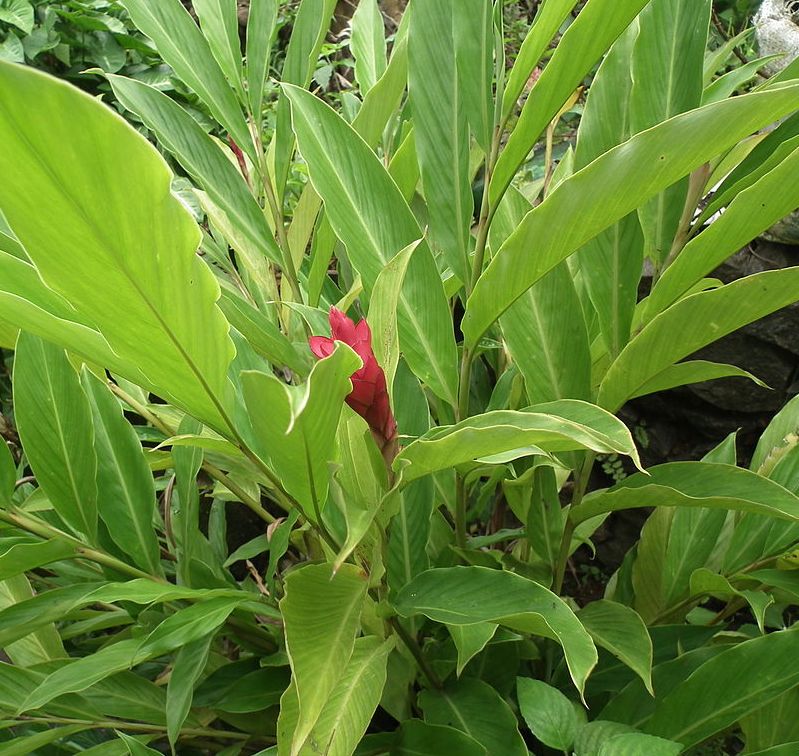
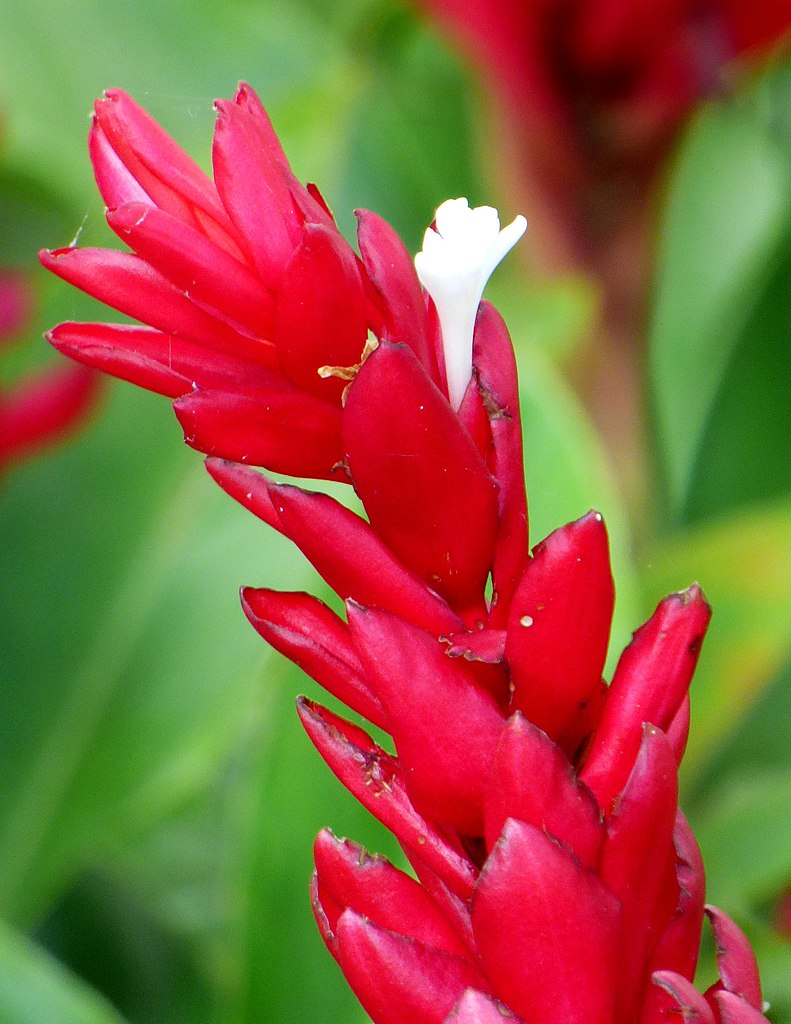
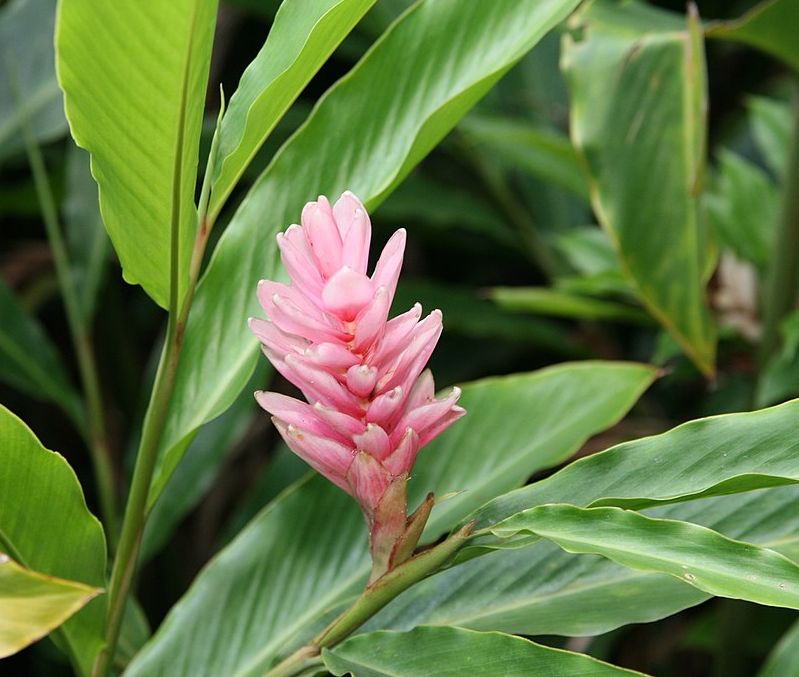
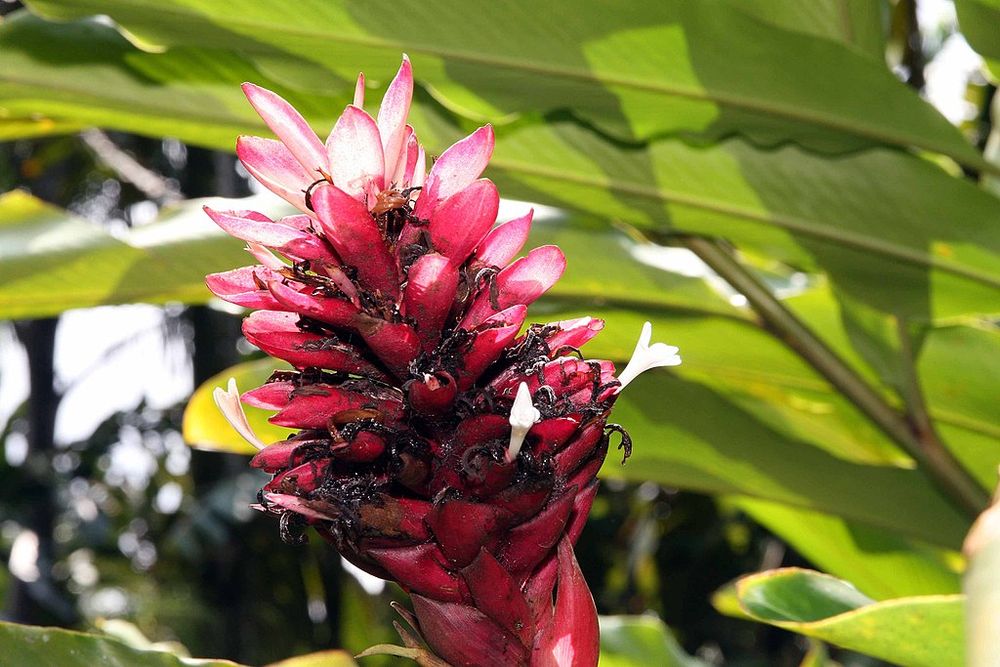
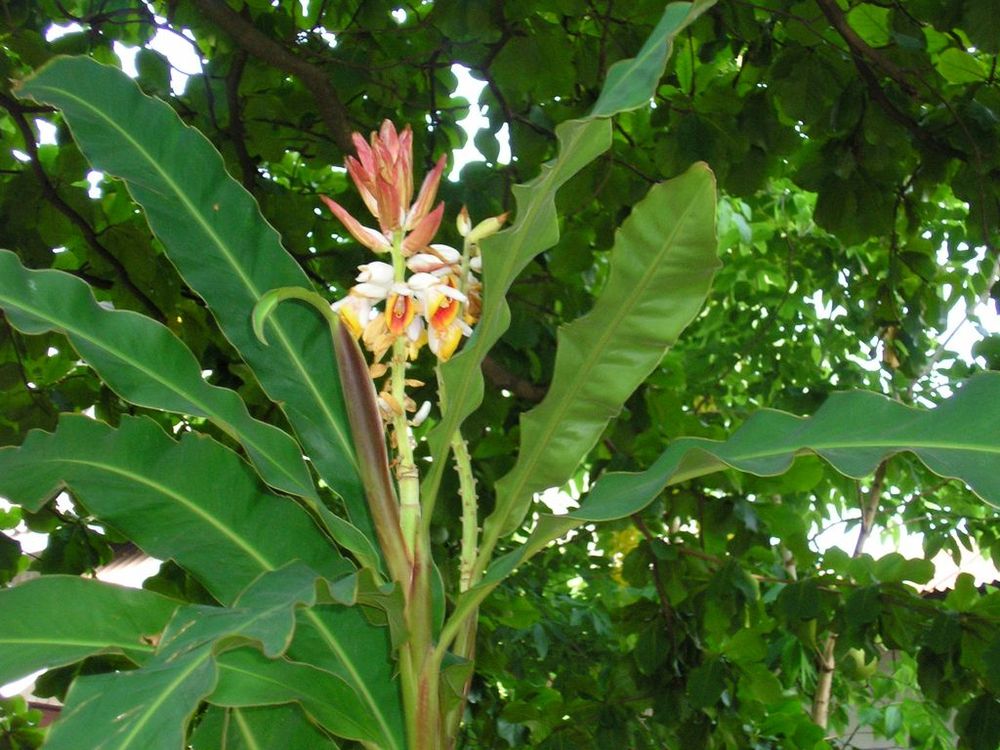
In Laos, we are familiar with one variety of Alpinia, called Galanga, kha in Lao, which is a major ingredient in the local cuisine. Alpinia purpurata is one of the strongest markers of the tropical landscape, with its strange and beautiful inflorescences.
Native to Indonesia and the Pacific, it has an ancient place in the classification of the Zingiberaceae family. Dedicated to Prosper Alpini, an Italian botanist of the Renaissance, this genus includes about twenty Asian and Oceanian species which develop, from a rhizome often rich in odorous resins, a stem with the appearance of a strong reed furnished with simple sheathing leaves; those of Alpinia purpurata measure from 30 to 70 cm in length with a very pronounced central vein. At the end of the stem appears a large, erect spike, sometimes hanging, composed of bright red or pink bracts, in the hollow of which are born very small, extremely discreet white flowers. The fruits are 3-celled capsules containing spherical black seeds.
The vernacular names of Alpinia purpurata, the purple alpinia, recall the colour of its inflorescence: kha dèng in Lao, “red galanga” or Red Ginger in English; the Creole of the West Indies will speak of lavande, because the erect spikes of the Alpinia resemble, in a much smaller way, those of the Mediterranean plant.
In the Pacific, the Alpinia is used to make necklaces and crowns, while in Laos it decorates gardens with its abundant foliage and rich colours. In addition, its sumptuous bracts are increasingly used to give florists’ bouquets an appreciable volume. You know of course that the reproduction of this beautiful plant is easy by taking the shoots from the faded inflorescences which are then put back into the ground.
However, the Lao flora is rich in other Alpinia, and we would like to mention another one: Alpinia bracteata, which is known here as kha khom, “bitter galanga” and which is a famous medicinal plant. Its bracts, although less voluminous than those of purpurata, are nonetheless very beautiful with more visible white flowers with an orange heart. But it is obviously its rhizome that is sometimes used as a condiment and, above all, gives decoctions that strengthen young mothers and cure stomach aches and flatulence.
Nor should we forget the magical powers of the Zingiberaceae, most of which are used to combat evil spirits; thus, among the Akha, a whip made of Alpinia leaves is used to strike the possessed person.
Nous connaissons bien au Laos une variété d’Alpinia, le Galanga, kha en lao, qui est un ingrédient majeur de la cuisine locale. Alpinia purpurata, quant à lui, par la beauté de ses étranges inflorescences, est l’un des marqueurs les plus forts du paysage tropical.
Originaire d’Indonésie et du pacifique il occupe une place ancienne dans la classification de la famille des Zingiberaceae. Dédié à Prosper Alpini, un botaniste italien de la Renaissance, ce genre comprend une vingtaine d’espèces asiatiques et océaniennes qui développe, à partir d’un rhizome souvent riche en résines odorantes, une tige ayant l’aspect d’un fort roseau garni de feuilles engainantes simples; celles d’Alpinia purpurata mesurent de 30 à 70 cm de long avec une nervure centrale très marquée. En bout de tige apparaît un gros épi dressé, parfois pendant, composé de bractées de couleur rouge vif ou rose, au creux desquelles naissent de très petites fleurs blanches extrêmement discrètes. Les fruits sont des capsules à 3 loges renfermant des graines noires sphériques.
Les noms vernaculaires d’Alpinia purpurata, l’alpinia pourpre, rappellent la couleur de ses inflorescences: kha dèng en lao, « galanga rouge » ou Red Ginger en anglais « gingembre rouge »; le créole des Antilles parlera de lavande, car les épis dressés de l’Alpinia ressemblent, en beaucoup plus petit, à ceux de la plante méditerranéenne.
Si dans le Pacifique l’alpinia est utilisé pour faire des colliers et des couronnes, au Laos il décore les jardins, autant par son feuillage abondant que par la richesse de ses coloris; en outre, et de plus en plus, ses somptueuses bractées donnent aux bouquets des fleuristes un volume appréciable. Vous savez bien entendu que la reproduction de cette belle plante est facile par le prélèvement des rejets sur les inflorescences fanées que l’on remet en terre ensuite.
Cependant la flore lao est riche de nombreux autres Alpinia, et nous en signalons un autre: Alpinia bracteata, que l’on nomme ici kha khom, « galanga amer » et qui est une plante médicinale réputée. Ses bractées, bien que moins volumineuses que celles de purpurata n’en sont pas moins très belles avec des fleurs plus visibles, blanches au cœur orange. Mais c’est évidemment son rhizome qui sert parfois de condiment et, surtout, donne des décoctions qui fortifient les jeunes accouchées et qui soignent les maux d’estomac et les flatulences.
N’oublions pas non plus les pouvoirs magiques des Zingiberaceae dont la plupart permette de lutter contre les esprits mauvais; ainsi c’est avec un fouet fait de feuilles d’Alpinia que, chez les Akha, on frappe la personne possédée.










In Laos, we are familiar with one variety of Alpinia, called Galanga, kha in Lao, which is a major ingredient in the local cuisine. Alpinia purpurata is one of the strongest markers of the tropical landscape, with its strange and beautiful inflorescences.
Native to Indonesia and the Pacific, it has an ancient place in the classification of the Zingiberaceae family. Dedicated to Prosper Alpini, an Italian botanist of the Renaissance, this genus includes about twenty Asian and Oceanian species which develop, from a rhizome often rich in odorous resins, a stem with the appearance of a strong reed furnished with simple sheathing leaves; those of Alpinia purpurata measure from 30 to 70 cm in length with a very pronounced central vein. At the end of the stem appears a large, erect spike, sometimes hanging, composed of bright red or pink bracts, in the hollow of which are born very small, extremely discreet white flowers. The fruits are 3-celled capsules containing spherical black seeds.
The vernacular names of Alpinia purpurata, the purple alpinia, recall the colour of its inflorescence: kha dèng in Lao, “red galanga” or Red Ginger in English; the Creole of the West Indies will speak of lavande, because the erect spikes of the Alpinia resemble, in a much smaller way, those of the Mediterranean plant.
In the Pacific, the Alpinia is used to make necklaces and crowns, while in Laos it decorates gardens with its abundant foliage and rich colours. In addition, its sumptuous bracts are increasingly used to give florists’ bouquets an appreciable volume. You know of course that the reproduction of this beautiful plant is easy by taking the shoots from the faded inflorescences which are then put back into the ground.
However, the Lao flora is rich in other Alpinia, and we would like to mention another one: Alpinia bracteata, which is known here as kha khom, “bitter galanga” and which is a famous medicinal plant. Its bracts, although less voluminous than those of purpurata, are nonetheless very beautiful with more visible white flowers with an orange heart. But it is obviously its rhizome that is sometimes used as a condiment and, above all, gives decoctions that strengthen young mothers and cure stomach aches and flatulence.
Nor should we forget the magical powers of the Zingiberaceae, most of which are used to combat evil spirits; thus, among the Akha, a whip made of Alpinia leaves is used to strike the possessed person.
Nous connaissons bien au Laos une variété d’Alpinia, le Galanga, kha en lao, qui est un ingrédient majeur de la cuisine locale. Alpinia purpurata, quant à lui, par la beauté de ses étranges inflorescences, est l’un des marqueurs les plus forts du paysage tropical.
Originaire d’Indonésie et du pacifique il occupe une place ancienne dans la classification de la famille des Zingiberaceae. Dédié à Prosper Alpini, un botaniste italien de la Renaissance, ce genre comprend une vingtaine d’espèces asiatiques et océaniennes qui développe, à partir d’un rhizome souvent riche en résines odorantes, une tige ayant l’aspect d’un fort roseau garni de feuilles engainantes simples; celles d’Alpinia purpurata mesurent de 30 à 70 cm de long avec une nervure centrale très marquée. En bout de tige apparaît un gros épi dressé, parfois pendant, composé de bractées de couleur rouge vif ou rose, au creux desquelles naissent de très petites fleurs blanches extrêmement discrètes. Les fruits sont des capsules à 3 loges renfermant des graines noires sphériques.
Les noms vernaculaires d’Alpinia purpurata, l’alpinia pourpre, rappellent la couleur de ses inflorescences: kha dèng en lao, « galanga rouge » ou Red Ginger en anglais « gingembre rouge »; le créole des Antilles parlera de lavande, car les épis dressés de l’Alpinia ressemblent, en beaucoup plus petit, à ceux de la plante méditerranéenne.
Si dans le Pacifique l’alpinia est utilisé pour faire des colliers et des couronnes, au Laos il décore les jardins, autant par son feuillage abondant que par la richesse de ses coloris; en outre, et de plus en plus, ses somptueuses bractées donnent aux bouquets des fleuristes un volume appréciable. Vous savez bien entendu que la reproduction de cette belle plante est facile par le prélèvement des rejets sur les inflorescences fanées que l’on remet en terre ensuite.
Cependant la flore lao est riche de nombreux autres Alpinia, et nous en signalons un autre: Alpinia bracteata, que l’on nomme ici kha khom, « galanga amer » et qui est une plante médicinale réputée. Ses bractées, bien que moins volumineuses que celles de purpurata n’en sont pas moins très belles avec des fleurs plus visibles, blanches au cœur orange. Mais c’est évidemment son rhizome qui sert parfois de condiment et, surtout, donne des décoctions qui fortifient les jeunes accouchées et qui soignent les maux d’estomac et les flatulences.
N’oublions pas non plus les pouvoirs magiques des Zingiberaceae dont la plupart permette de lutter contre les esprits mauvais; ainsi c’est avec un fouet fait de feuilles d’Alpinia que, chez les Akha, on frappe la personne possédée.


